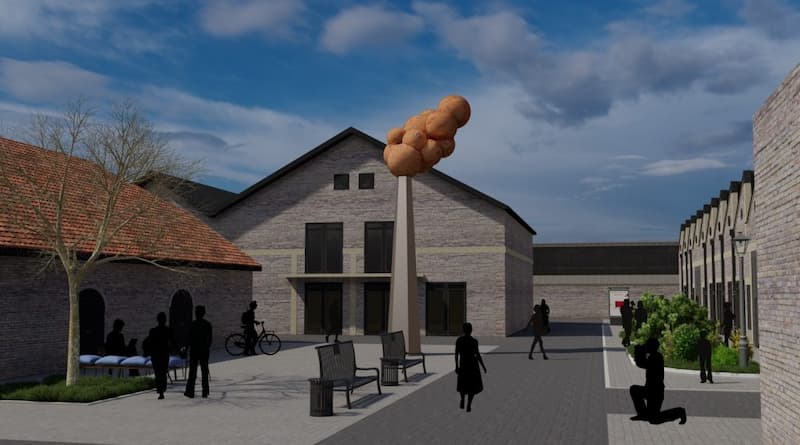In the place where chimneys and smoke from the first factories in Novi Sad once rose to the clouds, now another cloud will settle – an artistic one, which will have a very important role. On the one hand, it reminds us of those chimneys from which modern Novi Sad and its industrialization started, and on the other hand, it represents a new Novi Sad, from where creative industrialization starts.
It is the ‘Cloud’ structure, by the artist Branislav Nikolić, which will be installed in the District. ‘I like the idea of something as heavy and dense as terracotta material going up towards the sky and becoming a part of it. On the other hand, I tried to give it a certain visual lightness with a humorous, almost comic-like form. It looks like balls that flew to the sky.’
He further explains that the very name ‘Cloud’ sounded more poetic to him than the names ‘Smoke’ or ‘Chimney’, although his sculpture will essentially represent a factory chimney.
‘Considering that it will most often be viewed from below, it can be interpreted as a cloud in the sky. I often deal with architecture in my works, and I am especially inspired by factories, chimneys, and powerful industrial buildings in general. The District, as a former factory complex, was ideal for this kind of intervention,’ explains Nikolić, who got the opportunity to create a new symbol of the District as part of the sculpture-architecture call for the conceptual solution of creating a sculpture within the urban planning solution of the Novi Sad District, which was launched on the initiative of the’ Novi Sad – European Capital of Culture ’Foundation and the Centre for Fine and Applied Arts ‘TERRA’.
The call, which was opened on 1 January this year and lasted until 23 February, received 13 applications, and according to the jury, ‘Cloud’ was the most successful solution, which responded to the task, according to Anica Draganić, the member of the jury and the Associate Professor at the Faculty of Technical Sciences.
All the submitted works had certain symbolic and aesthetic qualities. However, several solutions were eliminated based on inadequate materialization, future exploitation and maintenance, as well as the technical feasibility of the solutions,’ Draganić said.

District as a Need and a Good Example
The reason for the call is an urban intervention in the public space, which involves placing a sculpture in the District, which aspires to become the most vibrant centre of creative industries in the region. Sculpture, and the method of its implementation should be a reflection of the ethics, aesthetics and values that make up the District, aimed at the evolution of artistic practices and contemporary approaches to art and cultural activities. In cooperation with the Centre for Fine and Applied Arts ‘TERRA’, the values specific to the identity of the area are promoted using terracotta as the dominant autochthonous medium for making sculptures.
The space of the District represents an attractive city location well connected to all key city traffic routes and qualities recognized within the local community, but also with the praise of other artists from Serbia, Europe and the world, who have already participated in numerous programmes. The basic idea is to create a network of cultural stations as new spaces for culture and position the District as a new focal point to decentralize the cultural map and establish a wide network of institutions aimed at strengthening the local cultural scene.
As Nikolić himself claims, Novi Sad was in need of such a place for a long time.
‘When I studied at the Academy of Arts in Novi Sad, the area of the nowaday District was a neglected, half-ruined complex, overgrown with weeds. I was surprised when I saw it recently. An excellent and logical decision to turn this neighbourhood into a space for culture, into studios for artists, galleries, libraries, small cultural centres, theatres, etc. I think that Novi Sad has long deserved a place like this and I am sure that numerous generations will gather around it in the future,’ says the artist and adds: ‘I was in Ljubljana lately. Around 30 years ago, local artists and musicians occupied the space of the former barracks in the centre of the city, and now almost all cultural institutions of Slovenia are located there. If that had not happened, the space would have been turned into apartments and passed from public to private ownership. The District is a true example of a smart decision to create such a core that has long been necessary for a city of culture,’ says Nikolić.
The importance of the location itself, not only for Novi Sad, but widely, is emphasized by the president of the jury, director of the Centre for Fine and Applied Arts ‘TERRA’ and academic sculptor, Slobodan Kojić, M.Sc.
‘I think that the city planners have determined an adequate place for placing the sculpture-symbol of the District. Considering the architectural interest, the size of the complex, which offers the possibility for various cultural contents, the space will play an extremely important role in Novi Sad, Vojvodina, Serbia and Europe,’ says Kojić.
Draganić agrees with Nikolić and Kojić.
‘The District is a pioneering example of an integrative approach to the restoration and revitalization of the industrial heritage in Novi Sad. I think that our city needs such a creative drive and I hope that in the future it will achieve programme diversity, which is necessary for the sustainability of the concept.’
You can read the entire text on the Dnevnik website.
Source: Dnevnik







